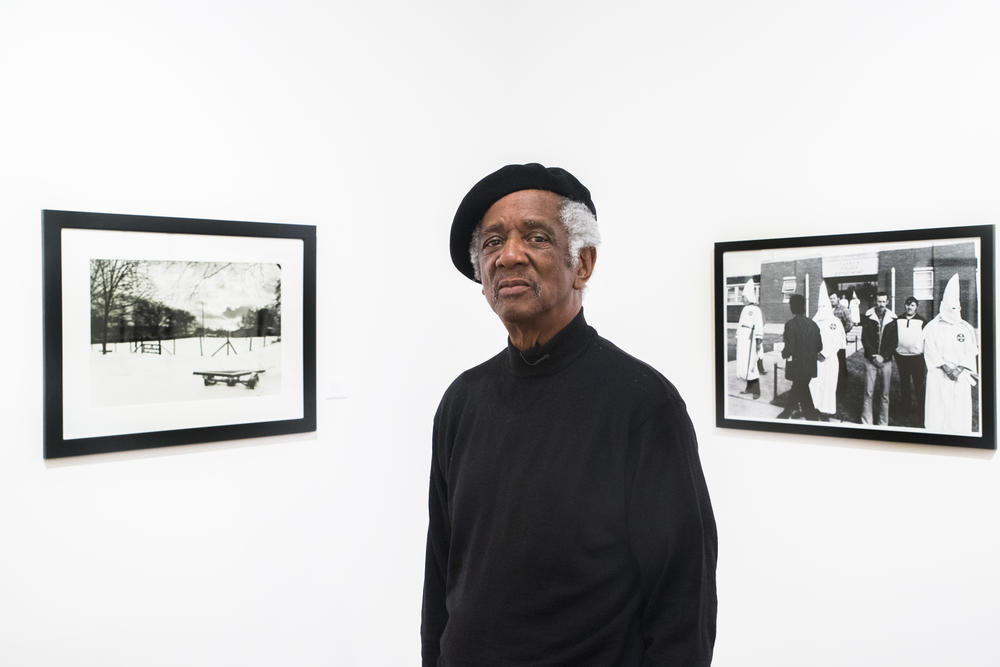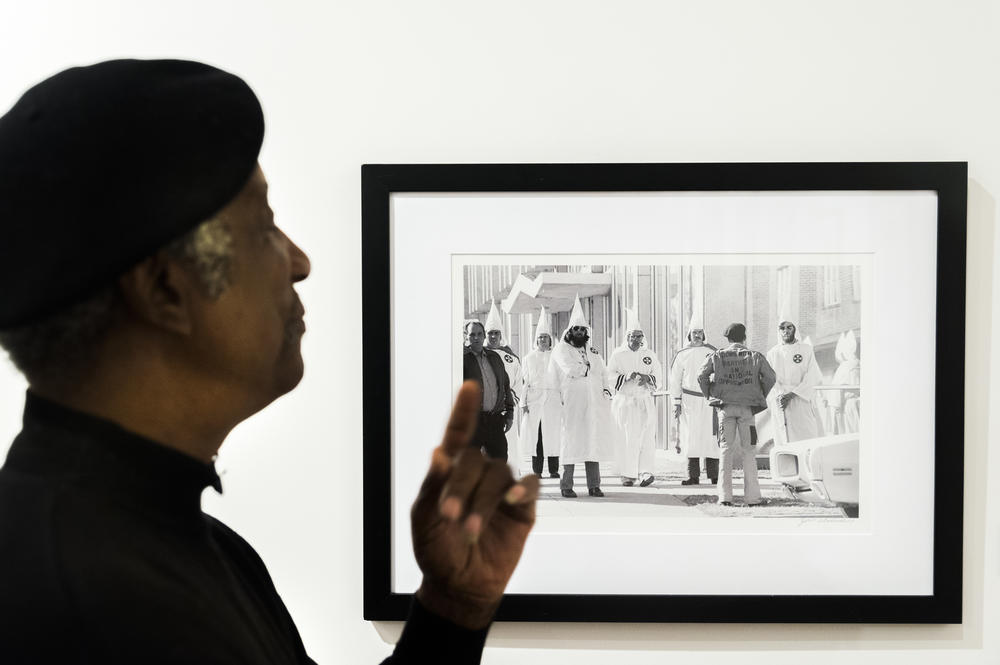Section Branding
Header Content
A Lifetime Of Photography For Change
Primary Content
Jim Alexander has done a lot of things.
At one time or another he has been a bookstore owner, the general manager of a newspaper delivery service and a car detailer. He ran a pool room, taught horseback riding and was a diesel engine mechanic in the Navy.
“So in my life I’ve done things,” he said
But what really defines Alexander are his camera and his activism.
The proof is on the gallery wall at the Tubman African American Museum in Macon in Alexander’s show Participant Observer. There you can find images of the black musicians and artists Alexander loves--Dizzy Gillespie, Duke Ellington, Eddie Kirkland among them. And of course politics---Ku Klux Klan protests, the South African Liberation movement, civil rights marches. To see how it started, Alexander showed me to an image of a tiny bed.
“Remember when I told you that I ran a pool room?” he asks. “In the pool room... upstairs over the pool room... was a rooming house. They had a rooming house up there they rented rooms to people. $9 a week.”
That was Alexander’s home through much of what he calls his “street time,” the years of drinking and gambling he had to get out of his system after his time in the Navy where he picked up photography. A fellow sailor had settled a gambling debt with Alexander with a Kodak Brownie.
This tiny bed in the photo was his refuge in during the street time years. Eventually he cleaned up, picked up a camera again and visited this place one more time.
“When I stopped drinking in 1964, I went back I guess maybe a year and a half later,” he said. “And I shot a picture of that room. That was my room.”
Light streams in from a slit through a window onto a slack pillow with the imprint of a sleeper’s head. Like all of Alexander’s work, this is a personal document.
Eventually Alexander worked nights in newspaper circulation in his native New Jersey and took pictures by day. He was immediately drawn to the growing political turmoil of the 1960s. He hung out in Harlem and found as his mentor the man who was then the nation’s most prominent black photojournalist, Gordon Parks. One day Parks told Alexander how he was trying to mount an exhibition of his LIFE magazine work.
“He said, ‘But I can't do it.’” he recalled. Alexander was incredulous.
“What do you mean you can't do it?” Alexander asked Parks.
“Well the pictures they want in the exhibit, I can't get the negatives because Life magazine owns all of that stuff,” Parks told him.
The show didn’t happen. This was around the time Martin Luther King Jr. was assassinated. Both events led Alexander to a life-defining decision to keep control of his own work.
“I said I'm just going to document black people for 10 years,” Alexander said. “Gordon's says to me ‘Well James,that sounds like a good idea but your ass is going to starve.’”
So Alexander decided to earn a photography degree and teach others to do what he loved at the same time. Parks approved.
“He said, that sounds different, that sounds better,” Alexander remembered.
The strategy worked. An image on another wall bears that out.
It captures a scene on the sidewalk in front of the Tupelo, Miss. Police Department on a day in 1978. By then Alexander was teaching in Atlanta. He took his students on a field trip to a Ku Klux Klan protest and rally.
In the photo are five men in full Klan regalia, white robes, hoods. One man has an axe handle in one hand and a cigarette in another. Then there are the men in street clothes.
“These guys are new recruits. They didn't quite get the uniforms yet,” Alexander said.
He used a wide angle lens and stood very close to these men. He wanted to record the whole scene. He doesn’t remember being afraid.
“Because my feeling? These guys here? In the daytime... their reputation is not about doing stuff in the daytime,” Alexander said.
As long as the sun was up, Alexander made photos. The photos only realized their ultimate importance when the sun went down.
Under the cover of darkness, Klan members assaulted protesters on their way out of Tupelo. When attorneys and activists found Alexander and asked for his images to help identify the Klan members, Alexander was happy to help.
“And they used those pictures to prosecute a lot of those people who were Klan,” he said.
Men went to jail with the help of Alexander’s photography. That was just one example of how he has used his photography as activism. That practice encouraged curator Jeff Bruce of the Tubman Museum to mount the show.
“The idea that he’s coming at this as a blank, just recording? No,” Bruce said. “Nowadays we live more in the era of advocacy. Everybody has a point of view and everybody is supposed to come at things with a point of view. He had that in advance.”
To maintain his freedom to use his work as he sees fit, Alexander says he has never made a picture for hire.
“The first thing comes through your head is the mentality of the media that you working for,” he said.
And Alexander said you can’t trust an editor to present things truthfully. Alexander once told an editor at the New York Times to take a hike for just this reason. But he knows his isn’t the only point of view
“I can’t tell you what you think is important isn’t,” he said. “I think it all needs to be documented.”
For Jim Alexander, people picking sides, presenting their case as honestly as they can, that’s how we all come together and eventually do what’s right.
Alexander’s show Participant Observer will be at the Tubman African American Museum in Macon through the end of March.
Support for Health, Education, and Poverty reporting on GPB Macon comes from the Peyton Anderson Foundation.



